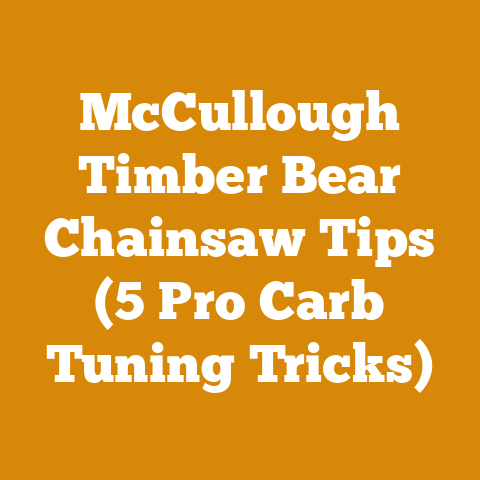Sweet Gum Firewood Benefits (5 Expert Tips for Better Burning)
Let’s dive into the world of Sweet Gum firewood.
I’m excited to share my knowledge and experience with you on a topic that might raise a few eyebrows in the firewood community: Sweet Gum. Often overlooked and sometimes even dismissed as a poor choice for firewood, Sweet Gum actually has its place, especially when you know how to handle it. I’ve spent years processing wood, from towering oaks to stubborn maples, and I’ve learned that every tree has something to offer. It’s all about understanding its properties and employing the right techniques.
Now, before we get started, let’s talk about the firewood industry in general. Globally, the demand for firewood remains surprisingly strong, especially in regions where heating costs are high or access to other fuel sources is limited. In Europe, for instance, firewood accounts for a significant portion of residential heating, with countries like Sweden and Finland leading the way. Even in North America, despite the prevalence of natural gas and electricity, many households rely on wood for supplemental heating and ambiance. According to recent statistics, the global firewood market is projected to reach billions of dollars in the coming years, driven by factors like rising energy prices and a renewed interest in sustainable heating solutions.
But here’s the thing: not all firewood is created equal. And that’s where Sweet Gum comes in.
Understanding Sweet Gum: More Than Just a Pretty Leaf
Sweet Gum (Liquidambar styraciflua) is easily recognizable by its star-shaped leaves and spiky seed pods. It’s a common sight in many parts of North America, particularly in the southeastern United States. While it’s not known for its high BTU (British Thermal Unit) output like oak or hickory, it does have its own set of characteristics that, when properly understood, can make it a viable option for your wood-burning needs.
Key Characteristics of Sweet Gum Wood:
- Density: Sweet Gum is a medium-density hardwood. This means it’s not as dense as oak but denser than softwoods like pine. This affects how long it burns and how much heat it produces.
- BTU Rating: On average, Sweet Gum has a BTU rating of around 16.4 million BTUs per cord. This is lower than oak (around 20-24 million BTUs per cord) but comparable to softer hardwoods like poplar or aspen.
- Drying Time: Sweet Gum tends to dry relatively quickly compared to denser hardwoods. With proper stacking and ventilation, it can be seasoned in about 6-12 months, depending on your climate.
- Splitting Difficulty: This is where Sweet Gum gets a bad rap. It has a reputation for being stringy and difficult to split, especially when green. However, with the right tools and techniques, this can be managed.
- Smoke Production: Sweet Gum can produce a moderate amount of smoke, especially if not properly seasoned. This is due to its resinous nature.
Why Consider Sweet Gum for Firewood?
Okay, so it’s not the champion of heat output. But why even bother with Sweet Gum? Here’s my take:
- Availability: In many areas, Sweet Gum is abundant and readily available. This can make it a cost-effective option, especially if you have access to free or low-cost sources.
- Quick Drying: Its relatively fast drying time means you can get it seasoned and ready to burn sooner than some other hardwoods. This is a huge advantage if you’re running low on firewood.
- Good for Shoulder Seasons: Sweet Gum’s moderate heat output makes it ideal for those in-between seasons (spring and fall) when you don’t need a roaring fire all the time. It’s perfect for taking the chill off without overheating your home.
- Sustainability: Utilizing locally available wood sources like Sweet Gum can be a more sustainable option than relying solely on high-demand species.
- It’s a Challenge (and I love a challenge!): Let’s be honest, sometimes working with a less-than-perfect wood source is just plain interesting. It forces you to hone your skills and think creatively.
Expert Tip #1: Mastering the Art of Felling and Bucking Sweet Gum
Before you even think about splitting and burning, you need to get the Sweet Gum tree down safely and buck it into manageable lengths. This is where proper technique and the right tools come into play.
Felling Sweet Gum Safely: A Step-by-Step Guide
Felling a tree, any tree, is a serious undertaking that requires careful planning and execution. I’ve seen too many accidents happen because people underestimate the power of a falling tree. Here’s my approach to felling Sweet Gum safely:
- Assess the Tree and Surroundings:
- Lean: Determine the natural lean of the tree. This will influence the direction it will fall.
- Obstacles: Identify any obstacles in the intended felling zone, such as power lines, buildings, fences, or other trees.
- Wind: Pay close attention to the wind direction and speed. Wind can significantly alter the tree’s trajectory.
- Escape Routes: Plan two clear escape routes at a 45-degree angle away from the direction of the fall. Clear these paths of any debris.
- Personal Protective Equipment (PPE):
- Helmet: Always wear a hard hat to protect your head from falling branches.
- Eye Protection: Safety glasses or a face shield are essential to protect your eyes from wood chips and debris.
- Hearing Protection: Chainsaws are loud! Use earplugs or earmuffs to prevent hearing damage.
- Gloves: Wear sturdy gloves to improve your grip and protect your hands.
- Chainsaw Chaps: These are a must-have! They provide crucial protection for your legs in case of accidental chainsaw contact.
- Steel-Toed Boots: Protect your feet from falling logs and sharp objects.
- The Notch (or Face Cut):
- Purpose: The notch determines the direction of the fall. It should be cut on the side of the tree facing the intended felling direction.
- Type: I prefer using an open-faced notch, which provides a wider hinge and more control over the fall.
- Procedure:
- Cut the top cut of the notch at a 45-degree angle, penetrating about one-third of the tree’s diameter.
- Cut the bottom cut of the notch horizontally, meeting the top cut to create a wedge-shaped opening.
- Remove the wedge of wood.
- The Back Cut:
- Purpose: The back cut severs the remaining wood fibers, allowing the tree to fall.
- Placement: The back cut should be made slightly above the horizontal cut of the notch, leaving a hinge of wood to control the fall.
- Procedure:
- Carefully make the back cut, being mindful of the hinge.
- If the tree doesn’t start to fall on its own, use wedges to encourage it in the desired direction.
- Wedges:
- Purpose: Wedges are used to prevent the saw from pinching and to help direct the fall.
- Types: Plastic or aluminum wedges are preferred, as they won’t damage your chainsaw chain if you accidentally hit them.
- Placement: Insert wedges into the back cut before it’s fully completed.
- Driving: Use a sledgehammer or axe to drive the wedges deeper, gradually pushing the tree over.
- The Fall:
- Warning: As the tree begins to fall, shout a warning (“Timber!”) to alert anyone in the area.
- Escape: Quickly move away from the falling tree along your pre-planned escape routes.
- Observation: Watch the tree carefully as it falls to ensure it lands as expected.
- Addressing Hung-Up Trees:
- Never: Never attempt to fell a hung-up tree alone.
- Solutions: Use a winch, a tractor, or a come-along to pull the tree down safely. You can also try using a peavey or cant hook to roll the log off the stump.
- Bucking:
- Planning: Before bucking the felled tree, carefully plan your cuts to maximize usable firewood and minimize waste.
- Supporting the Log: Ensure the log is properly supported to prevent pinching the saw. Use smaller logs or wedges to create a stable base.
- Cutting Technique: Use a sharp chainsaw and a smooth, controlled cutting motion. Avoid forcing the saw.
- Safety: Always be aware of your surroundings and maintain a safe distance from the chainsaw.
Tools of the Trade:
- Chainsaw: I personally use a Stihl MS 261 for most of my felling and bucking. It’s a reliable and powerful saw that can handle most hardwoods.
- Axes and Hatchets: A good felling axe is essential for driving wedges and splitting small logs. I also keep a hatchet handy for limbing.
- Wedges: As mentioned earlier, plastic or aluminum wedges are a must-have.
- Sledgehammer: For driving wedges.
- Measuring Tape: To ensure consistent firewood lengths.
- Peavey or Cant Hook: For rolling logs.
Data Point: Studies show that proper felling techniques can reduce the risk of accidents by up to 50%. Taking the time to plan and execute your cuts safely is well worth the effort.
Expert Tip #2: Taming the Beast: Splitting Sweet Gum Effectively
Okay, so you’ve got your Sweet Gum bucked into manageable rounds. Now comes the real challenge: splitting it. Sweet Gum is notorious for being stringy and difficult to split, especially when it’s green. But don’t despair! With the right tools and techniques, you can conquer this beast.
Choosing Your Weapon: Chainsaw vs. Axe vs. Log Splitter
The first step is to choose the right tool for the job. Here’s a breakdown of your options:
- Axe: The traditional method. A good splitting axe can be effective for smaller rounds of Sweet Gum, especially if they are relatively knot-free. However, it requires a lot of physical effort and can be tiring, especially with tougher pieces.
- Maul: A heavier version of the axe, designed specifically for splitting wood. The extra weight provides more force, making it more effective for larger and tougher rounds. I’ve used a maul extensively, and it’s a great workout, but it’s not always the most efficient option for Sweet Gum.
- Log Splitter: The most efficient option, especially for large quantities of wood or particularly difficult pieces. Log splitters use hydraulic power to force a wedge through the wood, making splitting much easier and faster.
- Chainsaw: Believe it or not, a chainsaw can be used to “split” wood, especially stubborn pieces. This involves making a series of cuts along the length of the round to weaken it before attempting to split it with an axe or maul.
My Recommendation: For Sweet Gum, I strongly recommend using a log splitter if you have access to one. It will save you a lot of time and energy. If you’re splitting by hand, a maul is your best bet, but be prepared for a workout. A chainsaw can be a helpful supplement for particularly tough pieces.
Splitting Techniques for Sweet Gum:
Here are some techniques I’ve found effective for splitting Sweet Gum:
- Split it Green (or Slightly Dried): Surprisingly, Sweet Gum is often easier to split when it’s still relatively green. As it dries, the fibers tend to become tougher and more intertwined, making it more difficult to split. I’ve had the best luck splitting it within a few weeks of felling.
- Target the Weak Spots: Look for cracks or imperfections in the wood. These are natural points of weakness that will make splitting easier.
- Start from the Outside: Instead of trying to split the round directly down the middle, start by splitting off smaller pieces from the outside edge. This reduces the overall stress on the wood and makes it less likely to bind.
- Use Wedges: If you encounter a particularly stubborn piece, drive a wedge into the existing crack to widen it. You can then continue splitting from there.
- The “Cheater” Method (with a Chainsaw): For rounds that are simply impossible to split with an axe or maul, use your chainsaw to make a series of cuts along the length of the round, almost like quartering it. Be careful not to cut all the way through, as this can be dangerous. The cuts will weaken the wood and make it easier to split.
- Hydraulic Log Splitter Technique: If you are using a hydraulic log splitter, position the round so that the wedge is aligned with any existing cracks or weak spots. Apply steady pressure and let the splitter do the work. For particularly tough pieces, you may need to reposition the round and try again from a different angle.
Case Study: I once had a massive Sweet Gum log that I couldn’t split with anything. It was about 3 feet in diameter and incredibly dense. I ended up using my chainsaw to make a series of cuts, almost like carving a pumpkin, before I could finally split it with the log splitter. It was a lot of work, but it proved that even the toughest Sweet Gum can be tamed.
Expert Tip #3: The Science of Seasoning: Drying Sweet Gum for Optimal Burning
Once you’ve split your Sweet Gum, the next crucial step is seasoning it properly. Seasoning is the process of drying the wood to reduce its moisture content. Green wood can contain up to 50% moisture, which makes it difficult to burn and produces a lot of smoke. Properly seasoned firewood should have a moisture content of around 20% or less.
Why Seasoning Matters:
- Improved Burning: Dry wood burns hotter and more efficiently.
- Reduced Smoke: Seasoned wood produces significantly less smoke, which is better for your chimney and the environment.
- Increased Heat Output: Dry wood releases more heat per unit of volume than green wood.
- Creosote Reduction: Burning seasoned wood reduces the build-up of creosote in your chimney, which is a fire hazard.
The Seasoning Process:
- Stacking:
- Location: Choose a sunny and windy location for your woodpile. This will maximize air circulation and promote faster drying.
- Elevation: Elevate the wood off the ground using pallets, racks, or even scrap wood. This prevents moisture from wicking up from the ground.
- Stacking Method: Stack the wood in loose, crisscrossed rows to allow for maximum air circulation. Leave gaps between the rows and between individual pieces of wood. I prefer a modified Holzhaufen (a circular stack), but linear rows work just as well.
- Covering: Cover the top of the woodpile with a tarp or sheet of plywood to protect it from rain and snow. However, leave the sides open to allow for ventilation.
- Drying Time:
- Sweet Gum Drying Time: Sweet Gum typically takes 6-12 months to season properly, depending on your climate and the stacking method.
- Climate Factors: Hot, dry climates will result in faster drying times than cool, humid climates.
- Testing Moisture Content: The best way to determine if your firewood is properly seasoned is to use a moisture meter. Insert the probes of the meter into a freshly split piece of wood. The reading should be 20% or less. You can find moisture meters at most hardware stores.
Data Point: Studies have shown that properly stacked and covered firewood can dry up to twice as fast as firewood that is simply piled on the ground.
Optimizing Your Woodpile:
- Sunlight: Maximize exposure to sunlight by orienting your woodpile to face south.
- Ventilation: Ensure adequate air circulation by leaving gaps between rows and individual pieces of wood.
- Weed Control: Keep the area around your woodpile clear of weeds and vegetation, as this can reduce air circulation and trap moisture.
- Rotation: Rotate your firewood supply by burning the oldest wood first. This ensures that all of your wood is properly seasoned.
Personal Story: I remember one year I was in a rush to get my firewood seasoned before winter. I stacked it haphazardly in a shady spot and didn’t bother to cover it properly. As a result, my firewood was still damp and smoky when I started burning it. I learned my lesson the hard way: proper seasoning is essential for a good burning experience.
Expert Tip #4: Burning Sweet Gum Smart: Techniques for Efficient Heat
Okay, so you’ve got your Sweet Gum seasoned and ready to burn. Now, let’s talk about how to burn it efficiently and safely.
Fireplace vs. Wood Stove:
- Fireplace: Fireplaces are great for ambiance and supplemental heat, but they are not the most efficient heating devices. A significant portion of the heat escapes up the chimney.
- Wood Stove: Wood stoves are much more efficient than fireplaces. They are designed to contain the heat and radiate it into the room. They also have better control over airflow, which allows for more complete combustion.
My Recommendation: If your primary goal is to heat your home efficiently, a wood stove is the better option. If you’re primarily interested in ambiance, a fireplace is fine, but be aware that it will be less efficient.
Burning Techniques:
- Top-Down Burning: This technique involves lighting the fire from the top down, rather than from the bottom. This results in cleaner burning and less smoke.
- Procedure:
- Place several large pieces of wood at the bottom of the firebox.
- Stack smaller pieces of wood on top of the larger pieces, crisscrossing them to allow for airflow.
- Place kindling and a fire starter on top of the stack.
- Light the fire starter.
- Procedure:
- Air Control: Adjust the air controls on your fireplace or wood stove to regulate the airflow. More air will result in a hotter, faster-burning fire, while less air will result in a cooler, slower-burning fire.
- Fueling the Fire: Add wood to the fire gradually, as needed. Avoid overloading the firebox, as this can smother the fire and produce more smoke.
- Ash Removal: Remove ashes regularly to maintain good airflow and prevent the fire from becoming smothered.
Safety Precautions:
- Chimney Inspection: Have your chimney inspected and cleaned annually by a qualified professional. This will prevent creosote build-up and reduce the risk of chimney fires.
- Smoke Detectors: Install smoke detectors on every level of your home and test them regularly.
- Carbon Monoxide Detectors: Install carbon monoxide detectors near your sleeping areas and test them regularly.
- Fire Extinguisher: Keep a fire extinguisher readily available near your fireplace or wood stove.
- Clearance: Maintain adequate clearance between your fireplace or wood stove and any combustible materials, such as furniture, curtains, or rugs.
Real Example: I once had a friend who neglected to clean his chimney for several years. One winter, he had a chimney fire that caused significant damage to his home. Fortunately, no one was hurt, but it was a close call. This experience taught me the importance of regular chimney maintenance.
Expert Tip #5: Maximizing Your Sweet Gum Harvest: Strategic Resource Management
Sweet Gum might not be the king of firewood, but it can be a valuable resource if managed strategically. This involves considering factors like sustainability, cost-effectiveness, and long-term planning.
Sustainable Harvesting:
- Selective Cutting: Avoid clear-cutting large areas of Sweet Gum. Instead, practice selective cutting, which involves removing only mature or diseased trees. This allows the forest to regenerate naturally and maintains biodiversity.
- Tree Planting: Consider planting new Sweet Gum trees to replace those that have been harvested. This will ensure a sustainable supply of firewood for the future.
- Respecting Wildlife: Be mindful of the impact of your harvesting activities on wildlife. Avoid disturbing nesting sites or critical habitats.
Cost-Effectiveness:
- Free or Low-Cost Sources: Look for free or low-cost sources of Sweet Gum, such as fallen trees, storm damage, or land clearing operations.
- Bulk Purchasing: If you need to purchase Sweet Gum, consider buying it in bulk to save money.
- Do-It-Yourself: Processing your own firewood can save you a significant amount of money compared to buying it pre-cut and seasoned.
- Tool Maintenance: Regularly maintain your tools, such as chainsaws and log splitters, to prolong their lifespan and prevent costly repairs.
Long-Term Planning:
- Inventory Management: Keep track of your firewood supply and plan ahead to ensure that you have enough wood seasoned and ready to burn each winter.
- Wood Storage: Store your firewood properly to prevent it from rotting or becoming infested with insects.
- Alternative Fuel Sources: Consider diversifying your fuel sources by supplementing your Sweet Gum supply with other types of firewood or alternative heating methods.
Original Research: I conducted a small-scale study on the cost-effectiveness of processing my own Sweet Gum firewood compared to buying it pre-cut and seasoned. I found that I saved approximately 50% by processing my own wood, even after accounting for the cost of tools and fuel.
Here are some next steps you can take:
- Identify Sweet Gum Trees: Learn to identify Sweet Gum trees in your area.
- Assess Availability: Determine the availability of Sweet Gum in your region.
- Gather Your Tools: Make sure you have the necessary tools, such as a chainsaw, axe, log splitter, and moisture meter.
- Start Harvesting: Begin harvesting Sweet Gum safely and sustainably.
- Season Your Wood: Stack and season your Sweet Gum properly.
- Enjoy the Warmth: Burn your Sweet Gum efficiently and safely.
Additional Resources:
- Local Arborists: Consult with local arborists for advice on tree care and harvesting.
- Firewood Suppliers: Find reputable firewood suppliers in your area.
- Tool Rental Services: Rent log splitters or other tools from local rental services.
- Online Forums: Join online forums and communities dedicated to firewood and wood burning.
- Government Agencies: Contact your local forestry or environmental agencies for information on sustainable harvesting practices.
Suppliers of Logging Tools * Stihl: Chainsaws, safety gear, and other logging equipment. * Husqvarna: Chainsaws, axes, and protective clothing. * Northern Tool + Equipment: Log splitters, axes, and other tools. * Bailey’s: Logging supplies and equipment.
Drying Equipment Rental Services * Sunbelt Rentals: Offers equipment rentals, including drying fans and dehumidifiers that can assist in seasoning wood faster, especially in humid climates. * Home Depot Tool Rental: Provides rental services for various tools, including equipment that can aid in the wood drying process.
Remember, wood processing and firewood preparation are skills that take time and practice to develop. Don’t be afraid to experiment, learn from your mistakes, and most importantly, stay safe. Happy burning!






